On February 7, 2019, an eerie Starbucks logo shedding blood appeared in Jong-ro. It was a global cage-free movement alliance that Animal Freedom Solidarity has been working with 58 animal protection groups from the OWA (Open Wing Alliance), to ask Starbucks to stop using cruel "cage eggs." Starbucks Korea has announced that it will reduce the use of unethical eggs in the future, but many of Korea's companies are still not responding to this global movement. So let's see what cage-free means, why it should be done, and what companies are doing it.
What is a cage egg?
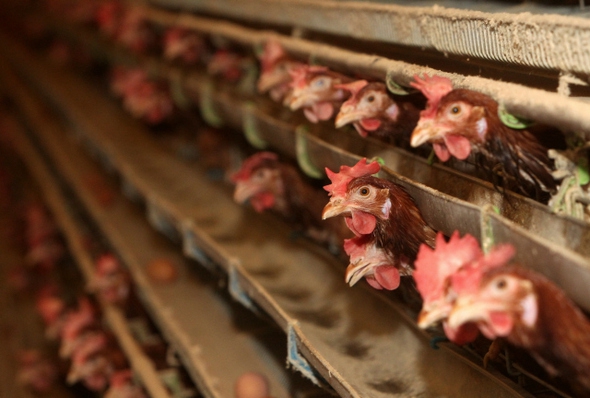 |
Cage eggs are eggs produced in a factory-style livestock system using a 'battery cage', commonly called a chicken coop. According to the regulations of the Ministry of Agriculture, Forestry and Livestock, the minimum rearing area of a laying hen has to be only 0.05 square meter (25x20 cm). It is just about the size of one A4 sheet of paper. It has been increased to 0.075 square meter since July 2017, but it is still too narrow. There are as many as 8 chickens in this space, giving birth to eggs until death. These breeding methods cause stress and illness to chickens. Because of calcium deficiency, it is easy for the hens to have leg fractures. In addition to this, the chicken can not spread its wings even once, it is caught in a barbed wire, and the bones are broken by being trampled on by other chickens. Not only that, but also the farmers light the cage for 24 hours everyday to stimulate the egg production rate. Besides, the chickens’ beaks are cut off in order to eliminate the risk of mutual attack or injury by chickens. Korea is no different. As for the egg production in Korea, about 1,000 farms are counted as laying hens. The farmers produce up to 70 million chickens per year, and an average of 40 million eggs are produced per day, also it turns out that Korea has an egg self-sufficiency rate over 100%. The consumption of eggs in Korea is estimated to be 13.5 billion a year as of 2017. It’s about 254 eggs are consumed per person per year. Although Japan's annual egg consumption per capita is about 340, the egg consumption in Korea is steadily increasing. In Korea, it is necessary to breed a large number of chickens in a narrow territory. Therefore the cage breeding method is prefered which can increase production despite low production cost. In fact, 95% of domestic farms produce cage eggs.
Cage Free Declaration in Korea
The biggest event in which the cage free movement emerged in Korea was that cage egg production was the main cause of the insecticide egg shock in 2017. The behavior of chickens bathing in sand is impossible in cage breeding. It gave rise to chicken ticks. In order to eliminate this, the pesticide bifenthrin was used in the farms. In the United States, bifenthrin is classified as a carcinogen, which can be used for chickens but cannot exceed the turbulence limit (0.01PPM). In some farms in Korea, the situation has become serious due to the detection of bifenthrin above the permitted level. Then, in 2017, the government announced that it would be obliged to provide animal welfare-type housing for new entrants. Also the cage farmers could receive government aid if they switch to an animal welfare type of chicken farm. This aid took the form of direct money (up to 20 million won) and funds to facilitate modernization. The government said that it plans to raise the proportion of animal welfare farmers from 8% to 30% by 2025. In October 2018, there are 116 farms certified as animal welfare by Ministry of Agriculture, Forestry and Livestock. Animal welfare certification was introduced in 2012 and is being implemented, at the agriculture, forestry and animal husbandry quarantine headquarters, to raise the level of welfare type farms. The farmers who receive more than 80 points in 61 items including breeding facilities, environment, specification management methods, and general standards can get the certification. However, the public voice for changing the egg production method is not so high yet. Still,more than 95% of the Korean eggs are still produced by the cage egg production method.
Recently, however, a movement for change has been seen in Korea. Influential companies responded to the steady efforts of the Animal Freedom Solidarity.
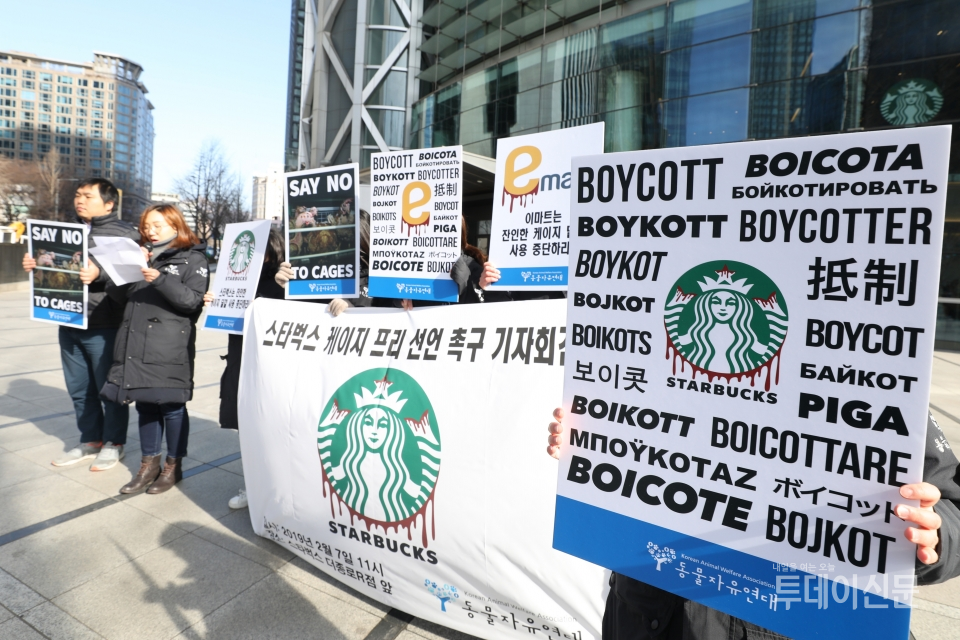 |
The most recent case was related to Starbucks Korea. Following the first boycott in Prague, Czech Republic in April 2018, Starbucks has pledged to become cage-free by 2020, but this is limited to stores operated by the company itself. 600 stores in China and 1,200 stores in Japan, which are operated by Starbucks, also will participate in the head office cage-free policy. In the meantime, Starbucks Korea, which operates more than 1,200 stores in Korea, has avoided the cage-free policy declaration and its implementation. In addition, Starbucks Korea, which posted sales of 1.2026 trillion won in 2017, was criticized because it did not show any signs of moving to cage-free eggs. On February 7, 2019, AFS (Animal Freedom Solidarity) and 58 animal groups from OWA (Open Wing Alliance), a global cage-free movement alliance, demanded the cessation of the use of caged egg to Starbucks Korea. They said "We want to ban the use of cruelty eggs in stores in all countries that operate under licenses like Starbucks Korea. Even now, I want to fulfill their social responsibilities through the cage-free declaration and implementation.” A few days later, Starbucks Korea announced that it will reduce the use of unethical eggs in the future.
Do you think such a movement can happen in Korean industry? On August 22, 2018, the food company, Pulmuone, which ranked first in the market with an 80% share of of the branded egg market, announced that it would become cage-free by 2028 in response to the demand of animal freedom associations. Since the cage-free announcement, Pulmuone has introduced a European open-type chicken house in Namwon, Jeollabuk-do. The farm maintains a density of less than 9 chickens per square meter, and does not use antibiotics in chickens. The main feature of the European open-type cage is the release of the chickens from the narrow chicken coops. Rather, it has an open-ended building with three floors inside so that the chicken can live freely. It is evaluated as a new realistic alternative of animal welfare in Korea. The reason for this evaluation is that it can breed more chickens per unit area than wide open cultivation and general plain cultivation, while complying with animal welfare certification standards. An official of Pulmuone explained "We plan to gradually root out the five remaining battery cage chicken farms by steps", "We already have been interested in the production of animal welfare since the 2000s and have prepared to become cage free before the request of global civic groups, AFS.
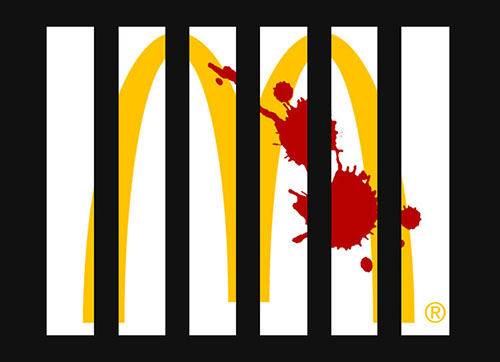 |
In addition, these movements lead to good results in other domestic companies. McDonald's in the US declared themselves to be cage-free in 2015, but McDonald's Korea, which did not even make any preparations, finally responded to the "unhappy meal" campaign of the Animal Freedom Solidarity in July 2018. This is not all the eggs that go into its products, but in the case of edible eggs used in the stores until 2025. And they announced that they would replace them with certified animal welfare eggs. In addition, since 2017, there has been a worldwide boycott by the AFS and 58 OWA affiliated organizations, including Korea, targeting Marriott companies known as luxury hotel brands that have not fulfilled their promises after the Cage Declaration in 2013. Then, in December 2018, at a global office, owned and operated by Marriott, the Cage Freedom Declaration was reopened to say they would use only cage-free eggs by the end of 2025. Marriott Korea representative promised that Marriott's global declaration will be implemented in Korea as well. Among domestic hotels, in Korea, Marriott has said that the company would change to cage-free, too.
Limits revealed
Although the cage-free declaration has been spreading globally, it is not practical for egg farmers who use cages, which keeps egg price low by the use of using factory-style mass production to switch to an animal welfare type of egg production in a narrow territory like Korea. Park Jin-yong, owner of an 11th-year cage-free farm, is operating an animal welfare farm approved by the government. But in an interview with the Asian economies in July 2018, he said, "Korea is not as wide as Europe and can not be 100% cage-free." The larger the size of the poultry farm, the larger the size of the breeding area. Kim Ki-yeon, head of the Agriculture, Forestry and Livestock Quarantine Division, said, "Last year, there were 40 applications for animal welfare certification for laying hens, but now there is no support from the central government. Moreover, productivity is inferior at the same scale. It is inevitable to reduce the number of individual eggs per unit area of space as they raise chickens without any cages. Generally, cage farms produce 40,000 to 50,000 eggs, but when they are open-type, they produce only 2,600 is the same amount of space. In addition, chickens that move out of the cage move a lot and feed rate is higher, but the egg production rate drops to 60 ~ 70%. There are also administrative expenses and land prices, so there is more burden than ever. As seen above, the production cost of general cage farms and animal welfare farms is between two and three times different. In the end, this will lead to rising egg prices. According to a survey by the National Statistical Office (NSO) in 2018, the average production cost of an egg is about 97 won, but the egg production cost of an animal welfare farm (cage free) is 250 to 300 won. This, in turn, leads to a decline in consumer demand, which poses a major threat to cage-free farms. The Rural Development Administration surveyed 502 women aged 25-29 in July 2017, and 42.5% said that they did not want to buy an animal welfare certified egg because of the "expensive price." In addition, in 2018, the Kim Sang-ho National Livestock Research Institute, Korea Poultry Research Institute, surveyed 600 domestic consumers, and even among those who answered that they would be willing to buy animal welfare eggs, half of them answered negatively after learning the price. In Korea, evaluation standards for animal welfare certified farms are still unclear and its effectiveness is also controversial. According to Article 29 (1) of the Animal Protection Act, it is stated that the ‘animal welfare farm’ is one which manages to keep the animals (cattle, pig, chicken, duck) in a way that they can live normally while maintaining their original habits. The law states that animal farms certified as animal welfare livestock farms can be supported. But the budget for guidance, counseling and education on improving environment and management of the housing facilities has not been specifically discussed. Getting a license is also difficult. In order to recieve a license, the farms should fulfill some strict conditions. For example, it is checked whether the farmer has affection for the domestic animals or has alleged abuse during transportation, and respect for the animal's right even when they are harvested. The biggest problem is that consumers in Korea are less aware of animal welfare in food manufacturing. As a result of the survey conducted by the Rural Development Administration on 'Consumer Perception of Animal Welfare Eggs' in 2018, 62.4% of consumers knew the word 'animal welfare', but only 37.8% knew of the animal welfare certification system. Only 23.3% of consumers know the animal welfare certification marks. This suggests that the demand for animal welfare eggs needs to increase both in households and in the industry, so farmers can turn their businesses into animal welfare farms. Even if it is a little expensive, it will be easier for producers to get into animal welfare form if there is consumers are willing to buy animal welfare eggs.
Cage-Free eggs overseas
Over the past 20 years, Europe hasre
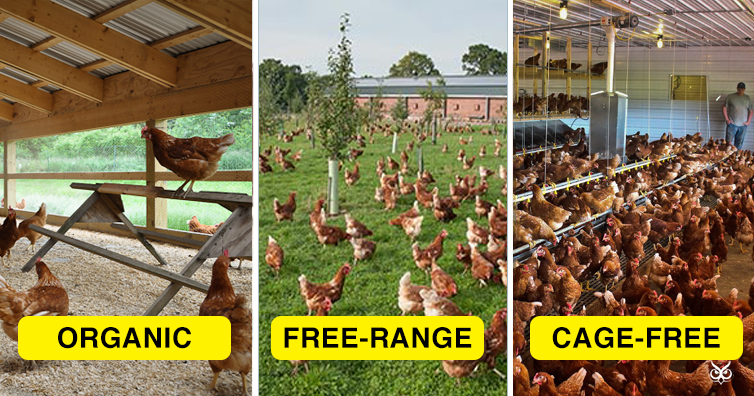 |
cognized the seriousness of this problem. The European Union (EU) has publicly discussed the problem of using battery cages for laying hens since 1998. Then EU decided to ban the use of battery cages in the European Union countries by 2012, and announced the cage-free declaration. Of course, they have not banned all cages and allowed some "enriched" cages, but the basic principal of animal welfare, which "prioritizes minimizing animal suffering," continues to exist. In the United States, the characteristics of farm animal welfare practices have been driven by the industry's own countermeasures rather than legal regulations, as opposed to the European Union. Nevertheless, it is considered to be one of the most active countries with cage-free declarations. More than 300 companies in the United States are reported to have joined the Cage Freedom Declaration. A diversity of companies, from distributors to restaurant chains, coffee shops, goods producers, egg producers, food service companies, and hotels have joined the cage-free declaration of eliminating all kinds of cages in the egg industry. According to the pressures from animal protection groups and consumer groups, large supermarkets or restaurant chains set up animal welfare standards on their own and received only products that comply with them.
The notable example is EU. The European Union already decided to stop the regular cage breeding in 2012. However, as of 2013, it showed that breeding of chicken free of cages including organic breeding and natural releasing was only 42.5% of the total. It is not a requirement to stop cage cultivation on all farms, but it provides financial support to farmers with standards that are above the legal requirements. The UE also imposes more taxes if adverse impacts on the environment, such as environmental pollution or animal suffering, are large. More than half of these were breeding “extended cages” which is large cages with dozens of chickens. The extended cage is a type that contains several chickens in a larger cage instead of keeping them in a narrow space, and can also practice animal welfare while reducing production costs a little. In the Netherlands, which is one of the largest egg producing countries in Europe, even expandable cages tend to disappear as consumers are opposed to them. The reason is that the extended cage, no matter how wide it is, does not allow chickens to move outside the cage, and is not good animal welfare. In the Netherlands, eggs produced in the expandable cage are the lowest 3 grades and are only used for processing. According to the animal welfare practice movement in Korea since 2016, the certification system of the RDA includes the 'Enriched Cage', which is an improved cage form for animal welfare type farms. However, there is no standard and only the existence of the cage is required for the animal welfare certification. It is necessary to widen the range of the cage type, or to find a practical way to prevent the cage from being used only when the chicken is growing like in the US.
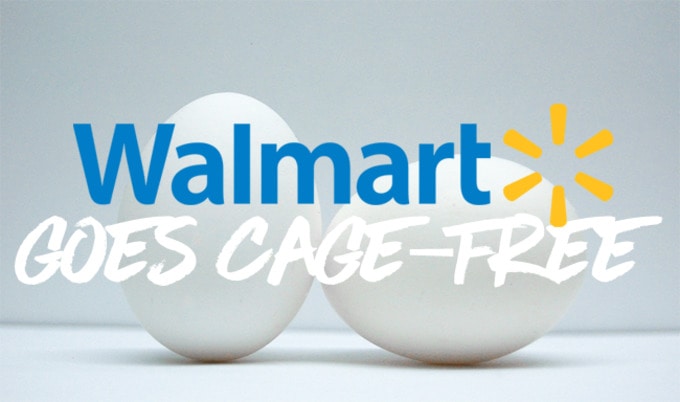 |
On the other side, there are active actions in distribution industries in USA and UK. The cage free movement cannot spread unless the distributor helps. US Wal-Mart and UK Tesco announced in 2016 that they would "stop selling cage eggs at stores by 2025". Wal-Mart is the world's largest retailer and Tesco is the third largest retailer. According to the US Department of Agriculture, a dozen cage-free eggs cost $2.99 when a dozen normal eggs cost $1.29 on average. It’s no wonder that cage-free eggs are more expensive than regular eggs. But if cage eggs are first removed from large-scale distributors, such as Wal-Mart or Tesco, where price competition is intense, a large number of egg farmers who wish to sell their eggs to large retail shop will be urged to change to cage-free. This finally leads to the price easing. This is because there is room for the price to go down if a large-scale mart is launched to increase cage-free egg production and sales. According to the World Agricultural Compassion, 20 million hens were raised in the UK in 2017. Tesco's measures have allowed two million laying hens to be released from the cage. Tesco said, "We have been working with industry experts for a long time to switch to a 100% cage-free egg." A Tesco official said, "We wanted to make sure that egg farms was invested to have a new production system." In addition, franchisees in US such as McDonald's, Burger King, and KFC have established their own standards for animal welfare for imported livestock products and are encouraging suppliers to comply with them.
The harmful treatment of animals eventually comes back to humans. I think it is fully proven by the swine flu in 2012 and the insecticide eggs in 2017. Consumers and retailers must first try to ensure awareness of animal welfare and to ensure safe food. Also, if the distributors first reach out to the large companies, the change will be significant. Right now, even though cage-free eggs are as expensive as luxury food, I think it is the only way to prevent the recurrence of such a disaster.
신지원 sjw46121@naver.com
<저작권자 © 인하프레스, 무단 전재 및 재배포 금지>

![[보도] 제43대 총학생회 후보자 공청회 개최돼](/news/photo/202404/11686_5015_2626.png) [보도] 제43대 총학생회 후보자 공청회 개최돼
[보도] 제43대 총학생회 후보자 공청회 개최돼
![[보도] 제43대 총학생회 후보자 공청회 개최돼](/news/thumbnail/202404/11686_5015_2626_v150.jpg)
![[보도] 총학생회장 선거 열려···학생사회 대표자는?](/news/thumbnail/202403/11668_5014_266_v150.jpg)
![[보도] 무전공·계열제 논의···학생은 어디에?](/news/thumbnail/202403/11666_5011_2238_v150.jpg)
![[보도] 인하 70돌, 다양한 행사 이어져](/news/thumbnail/202403/11663_5009_165_v150.jpg)
